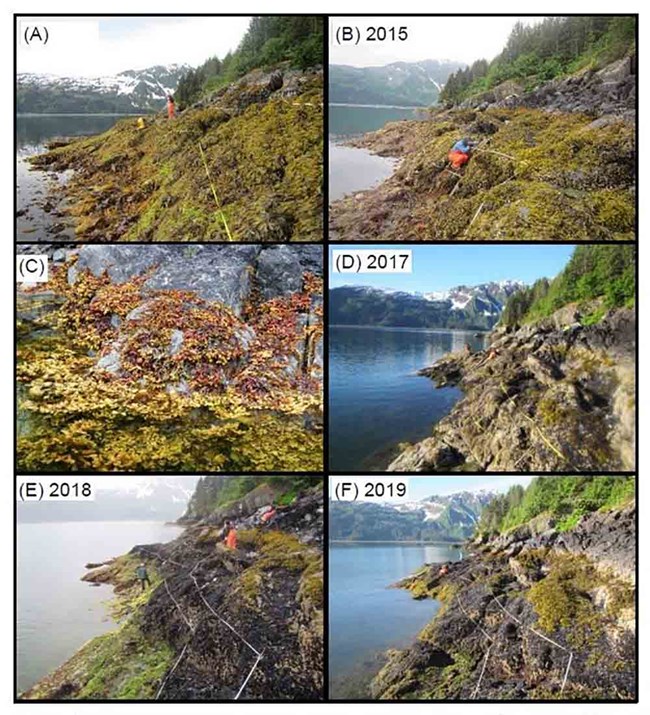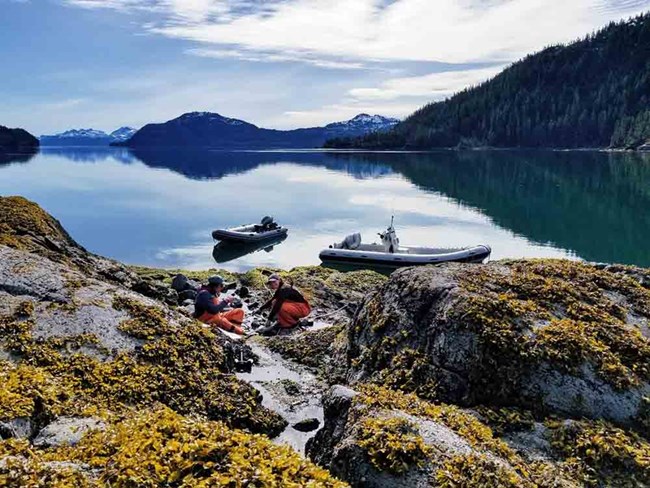Last updated: May 11, 2021
Article
Effects Continue from the Pacific Marine Heatwave

The recent Pacific Marine Heatwave (PMH) was unprecedented in its intensity and duration. Its spatial extent (the large area impacted), magnitude (how unusually warm it was), and duration (how long it lasted) made it the largest heatwave on record. While marine heatwaves have occurred in the past, they have become more prevalent and intense over the last century. The warm waters documented offshore also manifested in the coastal waters of the Gulf of Alaska. Changes from generally colder to warmer water anomalies were coincident with major changes in community structure at our intertidal sites. In the rocky intertidal, the Gulf Watch Alaska Long-term Monitoring Program documented changes in community structure across 21 rocky intertidal sites, covering four regions in the Gulf of Alaska (GOA) in response to the warming. The intertidal zone is a biome considered to be resilient to environmental extremes (heat, desiccation, storm surges, etc.). Intertidal communities are generally structured by local-scale drivers, but the strength and duration of the PMH overwhelmed those local scale influences. The result was the homogenization of these diverse communities across the Gulf through a shift from autotrophic dominated species (macroalgae) to one of heterotrophs (mussels and barnacles). This homogenization of marine communities has been documented elsewhere as a response to prolonged marine heatwaves. The loss of Fucus distichus (rockweed), one of the primary macroalgae in the rocky intertidal in the GOA, also meant the loss of a foundational species that creates habitat for other species. While Fucus was replaced by two other foundational species that also create habitat, mussels and barnacles, the shift in community composition, and hence, ecosystem function, will have to be evaluated over time (Weitzman et al. 2021).

USGS/Brian Robinson
Two other recent papers, also stemming from the collaborative Gulf Watch Alaska Long-term Monitoring Program, documented biological responses in the northern Gulf of Alaska to the recent Pacific Marine Heatwave (PMH). These responses occurred across food webs and biomes, from nearshore to offshore, and, in some cases, have persisted beyond the duration of the PMH in the North Pacific. In many cases, the perturbation was strong enough to override typical drivers of the system and it is uncertain whether the Gulf of Alaska will return to a pre-PMH state (Suryan et al. 2021).
For example, disruptions to the transfer of energy in the pelagic food web were driven by the heat-induced collapse of forage fish populations. Through varying life-histories of these forage fish species, this food web can be resilient to fluctuations in forage fish species’ abundance. However, the synchronous collapse of key forage fish populations, along with shifts in age structure, size, growth, and energy content suggests that the forage community as a whole was unable to mitigate adverse impacts of the heatwave, leading to the starvation of many seabirds, marine mammals, and other fishes (Arimitsu et al. 2021).
In summary, marine heatwaves are expected to become more common and widespread as a consequence of climate change. From primary producers to top-level consumers, our studies offer insight as to the varying extent of species’ responses to a wide-scale perturbation.
Learn more
Heatwave has lasting impacts on marine species, Public Radio for the Central Kenai Peninsula, April 7, 2021
2020 Gulf of Alaska Ecosystem Status Report (video), NOAA Alaska Fisheries Science Center, April 30, 2021
Years after the Pacific Marine Heatwave, Ecosystem shifts persist, EOS, May 3, 2021
Changes in Rocky Intertidal Community Structure During a Marine Heatwave in the Northern Gulf of Alaska
Abstract
Marine heatwaves are global phenomena that can have major impacts on the structure and function of coastal ecosystems. By mid-2014, the Pacific Marine Heatwave (PMH) was evident in intertidal waters of the northern Gulf of Alaska and persisted for multiple years. While offshore marine ecosystems are known to respond to these warmer waters, the response of rocky intertidal ecosystems to this warming is unclear. Intertidal communities link terrestrial and marine ecosystems and their resources are important to marine and terrestrial predators and to human communities for food and recreation, while simultaneously supporting a growing coastal tourism industry. Given that current climate change projections suggest increased frequency and duration of marine heatwaves, monitoring and understanding the impacts of heatwaves on intertidal habitats is important. As part of the Gulf Watch Alaska Long-Term Monitoring program, we examined rocky intertidal community structure at 21 sites across four regions spanning 1,200 km of coastline: Western Prince William Sound, Kenai Fjords National Park, Kachemak Bay, and Katmai National Park and Preserve. Sites were monitored annually from 2012 to 2019 at mid and low tidal strata. Before-PMH (2012–2014), community structure differed among regions. We found macroalgal foundation species declined during this period mirroring patterns observed elsewhere for subtidal habitat formers during heatwave events. The region-wide shift from an autotroph-macroalgal dominated rocky intertidal to a heterotroph-filter-feeder dominated state concurrent with the changing environmental conditions associated with a marine heatwave event suggests the PMH had Gulf-wide impacts to the structure of rocky intertidal communities. During/after-PMH (2015–2019), similarities in community structure increased across regions, leading to a greater homogenization of these communities, due to declines in macroalgal cover, driven mostly by a decline in the rockweed, Fucus distichus, and other fleshy red algae in 2015, followed by an increase in barnacle cover in 2016, and an increase in mussel cover in 2017. Strong, large-scale oceanographic events, like the PMH, may override local drivers to similarly influence patterns of intertidal community structure.
Weitzman, B., B. Konar, K. Iken, H. Coletti, D. Monson, R. Suryan, T. Dean, D. Hondolero, and M. Lindeberg. 2021. Changes in rocky intertidal community structure during a marine heatwave in the northern Gulf of Alaska. Frontiers in Marine Science 8:1-18.
Ecosystem response persists after a prolonged marine heatwave
Abstract
Some of the longest and most comprehensive marine ecosystem monitoring programs were established in the Gulf of Alaska following the environmental disaster of the Exxon Valdez oil spill over 30 years ago. These monitoring programs have been successful in assessing recovery from oil spill impacts, and their continuation decades later has now provided an unparalleled assessment of ecosystem responses to another newly emerging global threat, marine heatwaves. The 2014–2016 northeast Pacific marine heatwave (PMH) in the Gulf of Alaska was the longest lasting heatwave globally over the past decade, with some cooling, but also continued warm conditions through 2019. Our analysis of 187 time series from primary production to commercial fisheries and nearshore intertidal to offshore oceanic domains demonstrate abrupt changes across trophic levels, with many responses persisting up to at least 5 years after the onset of the heatwave. Furthermore, our suite of metrics showed novel community-level groupings relative to at least a decade prior to the heatwave. Given anticipated increases in marine heatwaves under current climate projections, it remains uncertain when or if the Gulf of Alaska ecosystem will return to a pre-PMH state.
Suryan, R. M., M. L. Arimitsu, H. A. Coletti, R. R. Hopcroft, M. R. Lindeberg, S. J. Barbeaux, S. D. Batten, W. J. Burt, M. A. Bishop, J. L. Bodkin, R. Brenner, R. W. Campbell, D. A. Cushing, S. L. Danielson, M. W. Dorn, B. Drummond, D. Esler, T. Gelatt, D. H. Hanselman, S. H. Hatch, S. Haught, K. Holderied, K. Iken, D. B. Irons, A. B. Kettle, D. G. Kimmel, B. Konar, K. J. Kuletz, B. J. Laurel, J. M. Maniscalco, C. Matkin, C. A. E. McKinstry, D. H. Monson, J. R. Moran, D. Olsen, W. A. Palsson, W. S. Pegau, J. F. Piatt, L. A. Rogers, N. A. Rojek, A. Schaefer, I. B. Spies, J. M. Straley, S. L. Strom, K. L. Sweeney, M. Szymkowiak, B. P. Weitzman, E. M. Yasumiishi, and S. G. Zador. 2021. Ecosystem response persists after a prolonged marine heatwave. Scientific Reports 11:6235.
Heatwave‐induced synchrony within forage fish portfolio disrupts energy flow to top pelagic predators
Abstract
During the Pacific marine heatwave of 2014–2016, abundance and quality of several key forage fish species in the Gulf of Alaska were simultaneously reduced throughout the system. Capelin (Mallotus catervarius), sand lance (Ammodytes personatus), and herring (Clupea pallasii) populations were at historically low levels, and within this community abrupt declines in portfolio effects identify trophic instability at the onset of the heatwave. Although compensatory changes in age structure, size, growth or energy content of forage fish were observed to varying degrees among all these forage fish, none were able to fully mitigate adverse impacts of the heatwave, which likely included both top‐down and bottom‐up forcing. Notably, changes to the demographic structure of forage fish suggested size‐selective removals typical of top‐down regulation. At the same time, changes in zooplankton communities may have driven bottom‐up regulation as copepod community structure shifted toward smaller, warm water species, and euphausiid biomass was reduced owing to the loss of cold‐water species. Mediated by these impacts on the forage fish community, an unprecedented disruption of the normal pelagic food web was signaled by higher trophic level disruptions during 2015–2016, when seabirds, marine mammals, and groundfish experienced shifts in distribution, mass mortalities, and reproductive failures. Unlike decadal‐scale variability underlying ecosystem regime shifts, the heatwave appeared to temporarily overwhelm the ability of the forage fish community to buffer against changes imposed by warm water anomalies, thereby eliminating any ecological advantages that may have accrued from having a suite of coexisting forage species with differing life‐history compensations.
Arimitsu, M. L., J. F. Piatt, S. Hatch, R. M. Suryan, S. Batten, M. A. Bishop, R. W. Campbell, H. Coletti, D. Cushing, K. Gorman, R. R. Hopcroft, K. J. Kuletz, C. Marsteller, C. McKinstry, D. McGowan, J. Moran, S. Pegau, A. Schaefer, S. Schoen, J. Straley, and V. R. von Biela. 2021. Heatwave-induced synchrony within forage fish portfolio disrupts energy flow to top pelagic predators. Global Change Biology
